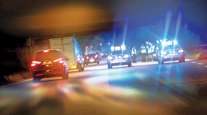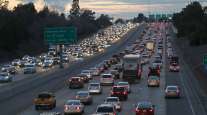Minnesota Legislators Debate Who Pays if Freight Train, Light Rail Collide

Residents have long worried about plans for Southwest light rail to operate alongside freight trains hauling ethanol, especially in densely populated areas such as Minneapolis.
That distress recently surfaced anew at the Legislature with a measure that would severely limit railroads’ liability if a catastrophic accident involving hazardous materials such as ethanol or crude oil occurred between LRT and freight haulers.
RELATED: New, safer US rail cars gather dust even as ethanol trains grow longer
Foes of the bill claim it offers little safeguard to protect residents, homes, businesses and the environment should a rail disaster occur. “This is a special-interest bill promoted by the railroad industry to absolve them of liability in case there’s an accident,” said Rep. Frank Hornstein, (DFL-Minneapolis), a longtime advocate of rail safety.
Those who support the bill say it offers reasonable protection to the public and to freight carriers.
Discussion at the Capitol about the proposal has focused almost exclusively on Glencoe-based Twin Cities & Western Railroad Co. (TC&W), which serves farmers in southwestern Minnesota who depend on the line to ship their products to markets worldwide. But bigger railroads also would be covered.
RELATED: Railroads struggling to meet federal safety deadlines triggered by deadly California crash
On average, privately held TC&W says it runs four to five trains through Minneapolis a day hauling commodities, such as corn, soybeans, grain and sugar beets. About two trains carrying ethanol rumble through the metro every week, according to TC&W President Mark Wegner. Some trains can stretch a mile long.
Scheduled to open in 2021, Southwest light rail will run adjacent to TC&W’s trains along the Kenilworth corridor near the busy Chain of Lakes area. About 210 light-rail trains will run daily on the route connecting Minneapolis to Eden Prairie, according to the Metropolitan Council.
The space between freight and Southwest LRT trains will vary from 25 feet to 50 feet along 7.65 miles of shared route between Minneapolis and Hopkins. About 10 feet will separate the two when LRT trains snake through a tunnel in the Kenilworth corridor.
TC&W says it will slow ethanol trains down to 10 mph through the corridor. Existing LRT trains travel at speeds usually 30 to 40 mph — and slower near stations.
Mary Pattock, a Southwest LRT critic who lives near the corridor, fears vapors from TC&W ethanol trains could be ignited by electrical wires energizing the light-rail vehicles. She notes the trains will run near Target Field, which can hold about 38,000 people during a baseball game.
RELATED: Two CSX trains in Florida collide, derail; two injured
“This is the catastrophe we desperately hope will never happen, but we know they do happen,” Pattock said.
Met Council officials say the LRT cars and wires will be designed to prevent sparking and will be monitored frequently.
They also note that light-rail trains operate within similar distances — or less — in Denver, St. Louis, Sacramento, Calif., Charlotte, N.C., and Portland, Ore.
Still, the broader issue of railroad liability has festered since 2013, when a train carrying North Dakota crude oil derailed in Lac-Mégantic, Quebec, leveling half the town and killing 47 people. The cleanup of the town and a nearby river is estimated to cost at least $1 billion, according to published reports.
The Canadian government has since adopted insurance liability requirements for rail companies, but no such restrictions exist in the United States.
RELATED: Oregon calls for indefinite moratorium on oil trains through the state
The Federal Railroad Administration does not require freight rail companies to carry a specified level of civil liability insurance.
However, the FAST Act passed during the Obama administration called for the U.S. Department of Transportation to study the insurance of rail carriers hauling hazardous materials. The results will be released this month.
The study comes after another rail disaster — this one involving ethanol — occurred in Iowa last month. A Union Pacific Railroad freight train derailed near Graettinger, in the northwest part of the state. Fifteen of the train’s 101 cars burned for more than 36 hours, but no one was injured or evacuated.
The issue of catastrophic liability recently surfaced during ongoing negotiations between the Met Council and TC&W. Wegner said his company wants similar protections offered to BNSF Railway for track shared with the Northstar Commuter line, which links downtown Minneapolis to Big Lake. So his firm’s lawyers contacted Rep. Paul Torkelson (R-Hanska).
Torkelson heads the House Transportation Finance Committee, and the bill quickly made its way into the Transportation Omnibus budget bill, which will be debated at the Capitol in coming weeks.
It calls for a $3 million liability cap for a catastrophe, with the limit increased to match the level of insurance carried by railroads. But railroads don’t divulge details about their insurance coverage.
“It’s a perfect storm here of secrecy and special-interest money at play,” Hornstein said.
But Torkelson says TC&W has operated safely through the Kenilworth corridor since the 1990s, and he doesn’t want to be “sued out of existence.”
Beyond TC&W, BNSF Railway and Canadian Pacific Railway also will co-locate along part of Southwest’s corridor. And BNSF trains are slated to run alongside the Bottineau LRT extension, which is expected to open in 2021 between downtown Minneapolis and Brooklyn Park.
The bill “opens the door for all railroads to be eligible for the cap,” said Claire Ruebeck, from the grass-roots group Citizens Acting for Rail Safety-Twin Cities. She said the legislation “unfairly creates winners and losers, and the losers are the people who live and work in a liability immunity zone.” About 60,000 residents live along Southwest’s route, according to census data.
For its part, the Met Council said in a statement that it is “committed to safe LRT operations in the shared corridor. The council continues to discuss the appropriate mix of liability and insurance with the freight railroads in the event of an incident involving freight rail and LRT.”
The specific amount of insurance coverage employed by the council will be finalized later, if Southwest and Bottineau survive Republican efforts to cancel both projects.




